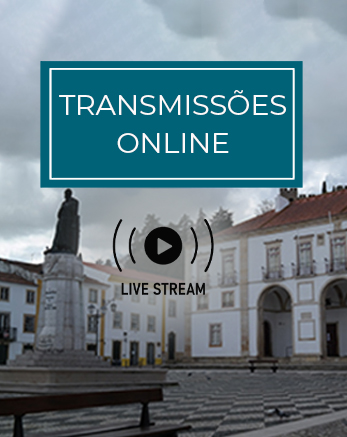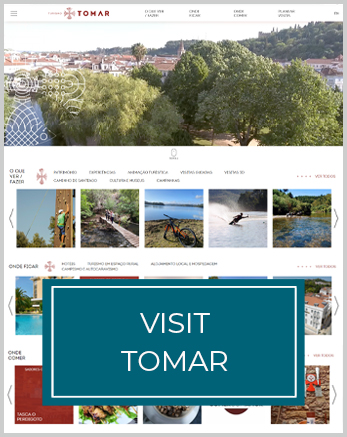Templários
- Detalhes
- Atualizado em 31-01-2024
CASTELO TEMPLÁRIO E CONVENTO DE CRISTO
TEMPLÁRIOS
MILITUM XPISTI
A Ordem dos Templários era uma Ordem religioso-militar medieval (séculos XlI / XIV) cuja sede portuguesa foi instalada em Tomar, em 1160, trinta e quatro anos após a sua chegada a Portugal. A Ordem fora criada para defesa dos Lugares Santos da Palestina e a  designação de “Ordem do Templo, ou Templária”, surge pelo facto de, em 1119, o primeiro Rei cristão de Jerusalém, Balduíno de Bolonha, ter cedido uma ala do seu palácio instalado na Mesquita de AI Aqsa (que fora construída “sobre” o desaparecido Templo de Salomão) para que se a Ordem se estabelecesse. A Divisa templário orienta a vida dos Cavaleiros, que devem fazer votos de pobreza, castidade e obediência, fazer jejuns e comer da mesma escudela. Essa Divisa (“Non nobis domine non nobis sed nomine tuo da gloriam.” -Não para nós, Senhor, não para nós, mas para a glória do Teu nome.) está inscrita no Estandarte quadrangular da Ordem rodeando as cores branca e negra, sobre as quais repousa a cruz pátea. O nome do Estandarte - Baucent - é também grito de guerra dos Cavaleiros que se equipam com cota de malha, elmo, calçado de ferro (sob um manto branco em que sobressai uma cruz vermelha), escudo, lança, maça de guerra, adagas e espada.
designação de “Ordem do Templo, ou Templária”, surge pelo facto de, em 1119, o primeiro Rei cristão de Jerusalém, Balduíno de Bolonha, ter cedido uma ala do seu palácio instalado na Mesquita de AI Aqsa (que fora construída “sobre” o desaparecido Templo de Salomão) para que se a Ordem se estabelecesse. A Divisa templário orienta a vida dos Cavaleiros, que devem fazer votos de pobreza, castidade e obediência, fazer jejuns e comer da mesma escudela. Essa Divisa (“Non nobis domine non nobis sed nomine tuo da gloriam.” -Não para nós, Senhor, não para nós, mas para a glória do Teu nome.) está inscrita no Estandarte quadrangular da Ordem rodeando as cores branca e negra, sobre as quais repousa a cruz pátea. O nome do Estandarte - Baucent - é também grito de guerra dos Cavaleiros que se equipam com cota de malha, elmo, calçado de ferro (sob um manto branco em que sobressai uma cruz vermelha), escudo, lança, maça de guerra, adagas e espada.
A Cruz adotada (1146) pelos Cavaleiros Templários, de origem oriental, era já usada havia muitos séculos. A sua divulgação deve-se à expansão do Cristianismo no Próximo Oriente, nomeadamente no Império Romano do Oriente (Bizantino). É uma cruz dita “pátea” por ter braços curvilíneos que se alargam do centro para as extremidades. O Selo Templário, circular, tem a inscrição “Siglium Militum Xpisti” (Sela da Milícia de Cristo) a rodear dois cavaleiros numa única montada. Logo após a sua criação, a Ordem estende-se a toda a Europa, chegando ao Condado Portucalense em 1126, sendo de 1128 a primeira referência documental conhecida.
É D. Teresa, mãe de D. Afonso Henriques, quem se apercebe da importância dos Templários para o Condado, concedendo-lhes Soure e todo o território compreendido entre Coimbra e Leiria. Com Portugal construído já como Reino independente, a “progressão” do país para sul é assegurada com a conquista de Santarém (1147); o reforço da defesa militar do território consolida-se mais a sul, em Tomar, com a concessão desta zona aos Templários, por D. Afonso Henriques, fundam a Tomar medieval com o início da construção do Castelo a 1 de Março de 1160 (até à entrada em vigor do Calendário Gregoriano, esta data marcava o início do ano civil, o que, aliado à proximidade do equinócio da Primavera e às manifestações iniciáticas dos Templários, poderia ter tido significativa influência na escolha do momento simbólico da instalação da Ordem). É, pois, a partir desta data que a Ordem aqui tem Sede Panteão (Igreja de Santa Maria do Olival) e convento (na mesma igreja), até à sua extinção (1312). A queda de S. João de Acre (1291), último bastião no Próximo Oriente, provoca a fuga dos sobreviventes Templários; um desses sobreviventes é Jacques de Molay, que será, no ano seguinte, eleito último Grão-Mestre Templário de Jerusalém e de França. O regresso dos Templários da Terra Santa e o seu enorme poderio, dão ao Rei Francês Filipe, o Belo, os motivos para os acusar de heresia e conseguir do Papa a suspensão dos seus privilégios, enfraquecendo-a perante a Igreja; confisca bens e propriedades, prende Cavaleiros e manda queimar o Grão-Mestre e os companheiros mais chegados. O Papa extingue a Ordem e doa os bens à Ordem do Hospital. As consequências são imediatas e a Ordem desmembra-se nas suas províncias; todavia, em Portugal D. Dinis contraria o processo e consegue a isenção da passagem dos bens templários para a Ordem do Hospital, a que se segue a criação da Ordem de Cristo (1319) que assume a herança do Templo.
MILITUM XPISTI
The Order of the Templars was a medieval religious and military Order (12th/14th centuries) and in 1160 its Portuguese headquarters was established in Tomar, thirty-four years aftet arriving in Portugal. The Order was created to defend the HoIy Sites in Palestine and was designated “Order of the Temple or Templars” due to the fact that, in 1119, the first Christian king in Jerusalem, Balduina of Bologna, had agreed to allow one wing of his palace, installed in the AI Aqsa Mosque (which had been built on top of what had been the Temple of Solomon), to be used to set up the Order. The Templars motto guided the life of the Knights who had to take vows of poverty, chastity and obedience, fast and eat from the some wooden bowl. Their motto (“Non nobis domine non nobis sed nomine tuo da gloriam’, - Not for us Lord, not foi us but for the glory of Thy name.) is written on the Orderis quadrangular standard encircling the black and white background to the “Pátea” cross. The standard is called Baucent, also the Knights war cry. The Knights wore coats of mail, helmets, and iron footwear, beneath a white cloak on which there was a large red cross and carried a shield, a lance, a club, a dagger anda sword. The Cross adopted in 1146 by lhe Knights of the Templars was of oriental origin and had already been in use for many centuries. It became common due to the expansion of Christianity in lhe Near East, namely the Eastern Roman Empire (Byzantium). It is called a ‘pátea” cross because it has curvilinear arms, which become wider from the centre to the ends. The circular Templar seal bears lhe inscription ‘Siglium Militum Xpisti’ around the edge with two knighls mounted on one horse in the centre. Right after it had been established, the Order spread throughout Europe, reaching the County of Portucale in 1126. The first documented reference to the Order was in 1128. It was D. Teresa, the mother of D. Afonso Henriques, who understood the importance of the Templars for the County, granting them Soure and all the territory between Coimbra and Leiria. With Portugal established as an independent kingdom, the expansion of the country southwards was assured by the conquest of Santarém in 1147. The military defence of the territory was reinforced further south in Tomar when D. Afonso Henriques granted this area to the Templars. Medieval Tomar was thus founded with the building of the Castle being started on March 1st 1160 (until the Gregorian calendar came into effect, this date had marked the start of the civil year, which was in fact linked to the Spring equinox and the Templars initiation ceremonies and could well have had a considerable influence on the choice of the symbolic moment at which to set up the Order). From that time on, the Order had its Seal, Pantheon (Santa Maria do Olival Church) and convent (mi the same church) until it was dissolved in 1312. The fall of S. João de Acre ( 291), the last bastion oftlhe Near East, caused the flight of the surviving Templars, one of whom was Jacques de Molay who was to become the last elected Templar Grand Master of Jerusalém and France. The return opf the Templars from the Holy Land and their enormous wealth gave the French King, Phillip the Fair, reasons to accuse them of heresy. He succededpersuading the Pope to suspend their privileges, weakeningtheir position in the Church, confiscated their property, arrested the Knights and had the Grand Master burnt alive along with his closest companions. The Pope dissolved the Order and donated their wealth to the Order of the Hospital. The consequences were immediate and the Order broke up in all areas. In Portugal, however, D. Dinis opposed the process and succeeded in preventing Templar property being handed over to the Order of the Hospital, creating forthwith Order of Christ (1319), which inherited the legacy of the Temple.
Palestine and was designated “Order of the Temple or Templars” due to the fact that, in 1119, the first Christian king in Jerusalem, Balduina of Bologna, had agreed to allow one wing of his palace, installed in the AI Aqsa Mosque (which had been built on top of what had been the Temple of Solomon), to be used to set up the Order. The Templars motto guided the life of the Knights who had to take vows of poverty, chastity and obedience, fast and eat from the some wooden bowl. Their motto (“Non nobis domine non nobis sed nomine tuo da gloriam’, - Not for us Lord, not foi us but for the glory of Thy name.) is written on the Orderis quadrangular standard encircling the black and white background to the “Pátea” cross. The standard is called Baucent, also the Knights war cry. The Knights wore coats of mail, helmets, and iron footwear, beneath a white cloak on which there was a large red cross and carried a shield, a lance, a club, a dagger anda sword. The Cross adopted in 1146 by lhe Knights of the Templars was of oriental origin and had already been in use for many centuries. It became common due to the expansion of Christianity in lhe Near East, namely the Eastern Roman Empire (Byzantium). It is called a ‘pátea” cross because it has curvilinear arms, which become wider from the centre to the ends. The circular Templar seal bears lhe inscription ‘Siglium Militum Xpisti’ around the edge with two knighls mounted on one horse in the centre. Right after it had been established, the Order spread throughout Europe, reaching the County of Portucale in 1126. The first documented reference to the Order was in 1128. It was D. Teresa, the mother of D. Afonso Henriques, who understood the importance of the Templars for the County, granting them Soure and all the territory between Coimbra and Leiria. With Portugal established as an independent kingdom, the expansion of the country southwards was assured by the conquest of Santarém in 1147. The military defence of the territory was reinforced further south in Tomar when D. Afonso Henriques granted this area to the Templars. Medieval Tomar was thus founded with the building of the Castle being started on March 1st 1160 (until the Gregorian calendar came into effect, this date had marked the start of the civil year, which was in fact linked to the Spring equinox and the Templars initiation ceremonies and could well have had a considerable influence on the choice of the symbolic moment at which to set up the Order). From that time on, the Order had its Seal, Pantheon (Santa Maria do Olival Church) and convent (mi the same church) until it was dissolved in 1312. The fall of S. João de Acre ( 291), the last bastion oftlhe Near East, caused the flight of the surviving Templars, one of whom was Jacques de Molay who was to become the last elected Templar Grand Master of Jerusalém and France. The return opf the Templars from the Holy Land and their enormous wealth gave the French King, Phillip the Fair, reasons to accuse them of heresy. He succededpersuading the Pope to suspend their privileges, weakeningtheir position in the Church, confiscated their property, arrested the Knights and had the Grand Master burnt alive along with his closest companions. The Pope dissolved the Order and donated their wealth to the Order of the Hospital. The consequences were immediate and the Order broke up in all areas. In Portugal, however, D. Dinis opposed the process and succeeded in preventing Templar property being handed over to the Order of the Hospital, creating forthwith Order of Christ (1319), which inherited the legacy of the Temple.
CASTELO DOS TEMPLÁRIOS
O Castelo Templário/Convento de Cristo foi sede da Ordem do Templo, até 1314, e da Ordem de Cristo, a partir de 1357. Do castelo (1160) faz parte a charola octogonal (finais do Séc. XII), santuário românico de influência oriental. Este conjunto foi  classificado pela UNESCO como Património Mundial em 1983. A sua área é de 54000 m2, sendo quarenta mil de área construída coberta, o que equivale à área de uma cidade média do período medieval. Objetivamente, é a maior área monumental de Portugal e uma das maiores do mundo. São três os centros de interesse a considerar para perceber o sítio: o artístico, consagrado em cada metro linear ou quadrado que se percorra e de que o Portal Principal, a Charola, a Janela da Capítulo e o Claustro de D. João III são picos de excelência; o funcional, que decorre das funções que teve alojando monges-guerreiros e frades em clausura, e a que não falta a mata para encontrar a Natureza; e o do duplo significado da consolidação de um País, primeiro, e a sua expansão pelo Mundo ao serviço de Cristo, depois. O Castelo dispõe de três recintos muralhados, sobressaindo os locais da Charola e da Torre de Menagem. A grande inovação surge com os portentosos “alombores” que guarnecem e reforçam a defesa da muralha. Entre a alcáçova e a charola, no espaço onde foram, no Séc. XV, os Paços do Infante, há vestígios da ocupação muçulmana. O início da construção do Convento deve-se ao Infante D. Henrique, que aqui levantou o seu Paço e os claustros da Lavagem e do Cemitério. A estes se juntariam, em Quinhentos, outros sete. São raríssimos, em todo o Mundo, edifícios com tantos claustros, pelo que o Convento também neste caso, assume particular significado. A Arquitetura em Portugal está aqui impressionantemente documentada, asseverando que os edifícios evoluem com quem os habita: a igreja/rotunda templária do Castelo é Românica; o Gótico mostra-se nos claustros do tempo do Infante D. Henrique; no início do Séc. XVI, o Manuelino mostra a sua exuberância na “Janela do Capítulo”; a ampliação do Convento, de D. João III até ao Séc. XVIII, emoldura o Renascimento; o Maneirismo e o Barroco marcaram os claustros da Hospedaria e no Principal e em muitos ornamentos. D. João V, no Séc. XVIII, interveio no púlpito, altar, coro e sacristia-mor. Com a aquisição do complexo, em meados do Séc. XIX, pelo Conde de Tomar, Costa Cabral, é criado em 1843, o primeiro posto de guarda do Convento, passando, desde então, oficialmente, a existir uma função cultural pública dependente do Ministério das Finanças. Só em 1986 esse serviço passa para a alçada dos responsáveis governamentais pela Cultura.
classificado pela UNESCO como Património Mundial em 1983. A sua área é de 54000 m2, sendo quarenta mil de área construída coberta, o que equivale à área de uma cidade média do período medieval. Objetivamente, é a maior área monumental de Portugal e uma das maiores do mundo. São três os centros de interesse a considerar para perceber o sítio: o artístico, consagrado em cada metro linear ou quadrado que se percorra e de que o Portal Principal, a Charola, a Janela da Capítulo e o Claustro de D. João III são picos de excelência; o funcional, que decorre das funções que teve alojando monges-guerreiros e frades em clausura, e a que não falta a mata para encontrar a Natureza; e o do duplo significado da consolidação de um País, primeiro, e a sua expansão pelo Mundo ao serviço de Cristo, depois. O Castelo dispõe de três recintos muralhados, sobressaindo os locais da Charola e da Torre de Menagem. A grande inovação surge com os portentosos “alombores” que guarnecem e reforçam a defesa da muralha. Entre a alcáçova e a charola, no espaço onde foram, no Séc. XV, os Paços do Infante, há vestígios da ocupação muçulmana. O início da construção do Convento deve-se ao Infante D. Henrique, que aqui levantou o seu Paço e os claustros da Lavagem e do Cemitério. A estes se juntariam, em Quinhentos, outros sete. São raríssimos, em todo o Mundo, edifícios com tantos claustros, pelo que o Convento também neste caso, assume particular significado. A Arquitetura em Portugal está aqui impressionantemente documentada, asseverando que os edifícios evoluem com quem os habita: a igreja/rotunda templária do Castelo é Românica; o Gótico mostra-se nos claustros do tempo do Infante D. Henrique; no início do Séc. XVI, o Manuelino mostra a sua exuberância na “Janela do Capítulo”; a ampliação do Convento, de D. João III até ao Séc. XVIII, emoldura o Renascimento; o Maneirismo e o Barroco marcaram os claustros da Hospedaria e no Principal e em muitos ornamentos. D. João V, no Séc. XVIII, interveio no púlpito, altar, coro e sacristia-mor. Com a aquisição do complexo, em meados do Séc. XIX, pelo Conde de Tomar, Costa Cabral, é criado em 1843, o primeiro posto de guarda do Convento, passando, desde então, oficialmente, a existir uma função cultural pública dependente do Ministério das Finanças. Só em 1986 esse serviço passa para a alçada dos responsáveis governamentais pela Cultura.
Morada:
Colina do Castelo
2300-000 TOMAR
Tel.: (+351) 249 315 089
Tel.: (+351) 249 313 434
Tel.:(+351) 249 313 481 (portaria do monumento)
Fax: (+351) 249 322 730
Este endereço de email está protegido contra piratas. Necessita ativar o JavaScript para o visualizar.
GPS:
39º 36' 14.8536" N
8º 25' 9.231" W
Bilhetes:
http://www.conventocristo.pt/pt/index.php?s=white&pid=172&identificador=ct24_pt
Horário:
Inverno (outubro a maio) 09h00 às 17h30 (Última entrada 17h00)
Verão (junho a setembro) 09h00 às 18h30 (Última entrada 18h00)
Encerrado dias de feriado, 1 de janeiro, Páscoa, 1 de maio e 25 de dezembro.
CASTLE OF THE TEMPLARS
The Templar Castle/Convent of Christ was seat of the Order of the Temple until 1314, and of the Order of Christ from 1357. Part of the castle (1160) is the late 12th century octagonal “Charola”, a Romanesque sanctuary of eastern influence. UNESCO classified this site as a World Heritage Monument in 1983. It covers an area of 54,000m2, forty thousand of which is built on, which is roughly the area of an average medieval town. In actual fact, it is the largest area convered by any monument in Portugal and one of the largest in the world. There are three aspects to consider in order to appreciate this place: the artistic, found in every linear or square metre you cross and of which thw main doorway, the Charola, the Chapter window and the D. João III Cloister are examples of excellence; the functional, in that its main function was to accommodate warrior-monks and reclusive monks. Where with the surrounding woodland Natura is ever present; and its double significante, first in the consolidation of a country, and then through its expansion throughout the worls in the service of Christ. The Castle has three walled enclosures, of which the most importante are those of the Charola and the donjon. The great innovation came with the portentous base supports, which strengthen the fortifications. Between the fortress and the Charola, in the area where in the 15Th century the Prince held court, there are traces of Muslim occupation. The initial building of the Convent is owed to Infante D. Henrique who, as well as building his court here, also built the washing and the cemetery cloisters. In the 1500’s another seven were added. There are hardly any buildings in the worls with as many cloisters, making the Convent a particulary significant example. Portuguese architecture is extremely well documented here, confirming that the buildings evolved with their residents: the Templar church/ rotunda in the castle is Romanesque; the Gothic is seen in the cloisters from the time of Infante D. Henrique; at the start of the 16th century, all the exuberance of the Manueline style is on show in the Chapter window; the Renaissance is seen in the alargement of the convent from D. João III until the 18th century; Mannerism and the Baroque leave their mark on the Hostel Cloister, the main one and on many ornaments. The intervention of D. João V can be seen in the pulpit, the altar, the chancel and the main sacristy. When the Count of Tomar, Costa Cabral acquired the complex in the 19th century the first guard post for the convent was crated in 1843 and since then it has officially had a public cultural function and been supported by the Exchenquer. Only in 1986 did this service come under the jurisdiction of the government´s cultural department.
this site as a World Heritage Monument in 1983. It covers an area of 54,000m2, forty thousand of which is built on, which is roughly the area of an average medieval town. In actual fact, it is the largest area convered by any monument in Portugal and one of the largest in the world. There are three aspects to consider in order to appreciate this place: the artistic, found in every linear or square metre you cross and of which thw main doorway, the Charola, the Chapter window and the D. João III Cloister are examples of excellence; the functional, in that its main function was to accommodate warrior-monks and reclusive monks. Where with the surrounding woodland Natura is ever present; and its double significante, first in the consolidation of a country, and then through its expansion throughout the worls in the service of Christ. The Castle has three walled enclosures, of which the most importante are those of the Charola and the donjon. The great innovation came with the portentous base supports, which strengthen the fortifications. Between the fortress and the Charola, in the area where in the 15Th century the Prince held court, there are traces of Muslim occupation. The initial building of the Convent is owed to Infante D. Henrique who, as well as building his court here, also built the washing and the cemetery cloisters. In the 1500’s another seven were added. There are hardly any buildings in the worls with as many cloisters, making the Convent a particulary significant example. Portuguese architecture is extremely well documented here, confirming that the buildings evolved with their residents: the Templar church/ rotunda in the castle is Romanesque; the Gothic is seen in the cloisters from the time of Infante D. Henrique; at the start of the 16th century, all the exuberance of the Manueline style is on show in the Chapter window; the Renaissance is seen in the alargement of the convent from D. João III until the 18th century; Mannerism and the Baroque leave their mark on the Hostel Cloister, the main one and on many ornaments. The intervention of D. João V can be seen in the pulpit, the altar, the chancel and the main sacristy. When the Count of Tomar, Costa Cabral acquired the complex in the 19th century the first guard post for the convent was crated in 1843 and since then it has officially had a public cultural function and been supported by the Exchenquer. Only in 1986 did this service come under the jurisdiction of the government´s cultural department.
Address:
Colina do Castelo
2300-000 TOMAR
Tel.: (+351) 249 315 089
Tel.: (+351) 249 313 434
Tel.: (+351) 249 313 481 (portaria do monumento)
Fax: (+351) 249 322 730
Este endereço de email está protegido contra piratas. Necessita ativar o JavaScript para o visualizar.
GPS:
39º 36' 14.8536" N
8° 25' 9.231" W
Tickets:
http://www.conventocristo.pt/pt/index.php?s=white&pid=172&identificador=ct24_pt
Schedule:
Winter (October to May) 9h to 17h30 (Last entry 17h00)
Summer (June to September) 9h to 18h30 (Last entry 18h00)
Closed on public holidays, January 1, Easter, May 1 and December 25.
Livro infantil "Tomar e os Templários" de Carlos Trincão




















